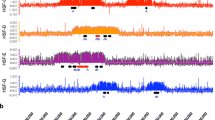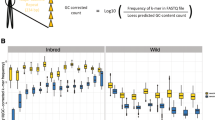Abstract
Cytologically, the centromere is found at the very end of most Mus musculus chromosomes, co-localizing with an array of minor satellite sequences. It is separated from the euchromatin of the long arm by a large domain of heterochromatin, composed in part of arrays of major satellite sequences. We used oligonucleotide probes that specifically detect regions of sequence variation found in certain cloned minor satellite sequences. They detect a limited subset of the minor satellite arrays in the mouse genome, based on both pulsed-field gel electrophoresis and in situ hybridization data, and provide direct molecular genetic markers for individual centromeres in some inbred mouse strains. Array size polymorphisms detected by these probes map to positions consisten with the centromeres of chromosomes 1 and 14 in the BXD recombinant inbred (RI) strains. The genetic distances between these minor satellite arrays and loci on the long arms of chromosomes 1 and 14 are consistent with repression of meiotic recombination in the heterochromatic domains separating them. The existence of chromosome-specific minor satellite sequences implies that the rate of sequence exchange between non-homologous chromosomes relative to the rate between homologous chromosomes is much lower than has previously been postulated. We suggest that the high degree of sequence homogeneity of mouse satellite sequences may instead reflect recent common ancestry.
Similar content being viewed by others
References
Allshire RC, Cranston G, Gosden JR, Maule JC, Hastie ND, Fantes PA (1987) A fission yeast chromosome can replicate autonomously in mouse cells. Cell 50:391–403
Bonhomme F, Guénet J-L (1989) The wild house mouse and its relative. In: Lyon MF, Searle AG (eds) Genetic variants and strains of the laboratory mouse. Oxford University Press, Oxford, pp 649–662
Broccoli D, Miller OJ, Miller DA (1990) Relationship of mouse minor satellite DNA to centromere activity. Cytogenet Cell Genet 54:182–186
Broccoli D, Trevor KT, Miller OJ, Miller DA (1991) Isolation of a variant family of mouse minor satellite DNA that hybridizes preferentially to chromosome 4. Genomics 10:68–74
Choo KH (1990) Role of acrocentric cen-per satellite DNA in Robertsonian translocation and chromosomal non-disjunction. Mol Biol Med 7:437–449
Choo KH, Vissel B, Nagy A, Earle E, Kalitsis P (1991) A survey of the genomic distribution of alpha satellite DNA on all the human chromosomes, and derivation of a new consensus sequence. Nucleic Acids Res 19:1179–1182
Cui X, Gerwin J, Navidi W, Li H, Kuehn M, Arnheim N (1992) Gene-centromere linkage mapping by PCR analysis of individual oocytes. Genomics 13:713–717
Davisson MT, Akeson EC (1992) Maps of centromere ends of chromosomes. Mouse Genome90:218–219
Davisson MT, Akeson EC (1992) Recombination suppression by heterozygous Robertsonian chromosomes in the mouse. Genetics 133:649–667
Dietrich W, Katz H, Lincoln SE, Shin H-S, Friedman J, Dracopoli NC, Lander ES (1992) A genetic map of the mouse suitable for typing intraspecific crosses. Genetic 131:423–447
Dod B, Mottez E, Desmarais E, Bonhomme F, Roizés G (1989) Concerted evolution of light satellite DNA in genus Mus implies amplification and homogenization of large blocks of repeats. Mol Biol Evol 6:478–491
Douville PJ, Carboneto S (1992) Genetic linkage analysis in recombinant inbred mice of P40, a putative clone for the high-affinity laminin receptor. Mammalian Genome 3:438–446
Earnshaw WC, Ratrie H, Stetten G (1989) Visualization of centromere proteins CENP-B and CENP-C on a stable dicentric chromosome in cytological spreads. Chromosoma 98:1–12
Eppig JT, Eicher EM (1983) Application of the ovarian teratoma mapping method in the mouse. Genetics 103:797–812
Evans EP (1981) Karyotype of the house mouse. In: Berry RJ (ed) Biology of the house mouse. Symp Zool Soc Lond 47: 127–139
Feinberg AP, Vogelstein B (1983) A technique for radiolabelling DNA restriction endonuclease fragments to high specific activity. Anal Biochem 132:6–13
Frankel WN, Stoye JP, Taylor BA, Coffin JM (1989) Genetic identification of endogenous polytropic proviruses using recombinant inbred mice. J Virol 63:3810–3821
Goldberg GI, Collier I, Cassel A (1983) Specific DNA sequences associated with the nuclear matrix in synchronized mouse 3T3 cells. Proc Natl Acad Sci USA 80:6887–6891
Gosden J, Hanratty D, Starling J, Fantes J, Mitchell A, Porteous D (1981) Oligonucleotide-primed in situ DNA synthesis (PRINS): a method for chromosome mapping, banding, and investigation of sequence organization. Cytogenet Cell Genet 57:100–104
Hayashi T, Ohtsuka H, Kuwabara K, Mafune Y, Miyashita N, Moriwaki K, Takahashi Y, Kominami R (1993) A variant family of mouse minor satellite located on the centromeric region of chromosome 2. Genomics 17:490–492
Joseph A, Mitchell AR, Miller OJ (1989) The organization of the mouse satellite DNA at centromeres. Exp Cell Res 183:494–500
Kipling D, Cooke HJ(1990) Hypervariable ultra-long telomeres in mice. Nature 347:400–402
Kipling D Ackford HE, Taylor BA, Cooke HJ (1991) Mouse minor satellite DNA genetically maps to the centromere and is physically linked to the proximal telomere. Genomics 11:235–241
Koch JE, Kølvraa S, Petersen KB, Gregersen N, Bolund L (1989) Oligonucleotide-priming methods for the chromosome-specific labelling of alpha satellite DNA in situ. Chromosoma 98:259–265
Mahtani MM, Willard HF, (1990) Pulsed-field gel analysis of α-satellite DNA at the human X chromosome centromere: high-frequency polymorphisms and array size estimate. Genomics 7:607–613
Marçais B, Bellis M, Gérard A, Pagès M, Boublik Y, Roizès G (1991) Structural organizations and polymorphism of the alpha satellite DNA sequences of chromosomes 13 and 21 as revealed by pulse field gel electrophoresis. Hum Genet 86:311–316
Masumoto H, Masukata H, Muro Y, Nozaki N, Okazaki T (1989) A human centromere antigen (CENP-B) interacts with a short specific sequence in alphoid DNA, a human centromeric satellite. J Cell Biol 109:1963–1973
Matsuda Y, Chapman VM (1991) In situ analysis of centromeric satellite DNA segregating in Mus species crosses. Mammalian Genome 1:71–77
Miles JS, Moss JE, Taylor BA, Burchell B, Wolf CR (1991) Mapping genes encoding drug-metabolizing enzymes in recombinant inbred mice. Genomics 11:309–316
Mitchell A, Jeppesen P, Hanratty D, Gosden J (1992) The organisation of repetitive DNA sequences on human chromosomes with respect to the kinetochore analysed using a combination of oligonucleotide primers and CREST anticentromere serum. chromosoma 101:333–341
Moens PB, Pearlman RE (1990) Telomere and centromere DNA are associated with the cores of meiotic prophase chromosomes. Chromosoma 100:8–14
Nadeau JH, Compton JG, Giguère V, Rossant J, Varmuza S (1992) Close linkage of retinoic acid receptor genes with homeobox-and keratin-encoding genes on paralogous segments of mouse Chromosomes 11 and 15. Mammalian Genome 3:202–208
Narayanswami S, Doggett NA, Clark LM, Hildebrand CE, Weier H-U, Hamkalo BA (1992) Cytological and molecular characterization of centromeres in Mus domesticus and Mus spretus. Mammalian Genome 2:186–194
Neuer-Nitsche B, Lu X, Werner D (1988) Functional role of a highly repetitive DNA sequence in anchorage of the mouse genome. Nucleic Acids Res 16:8351–8360
Pietras DF, Bennett KL, Siracusa LD, Woodworth-Gutai M, Chapman VM, Gross KW, Kane-Haas C, Hastie ND (1983) Construction of a small Mus musculus repetitive DNA library: identification of a new satellite sequence in Mus musculus. Nucleic Acids Res 11:6965–6983
Padic MZ, Lundgren K, Hamkalo BA (1987) Curvature of mouse satellite DNA and condensation of heterochromatin. Cell 50:1101–1108
Richards-Smith BA, Elliot RW (1992) Mapping of the mouse orinithine decarboxylase-related sequence family. Mammalian Genome 2:215–232
Silver J, Buckler CE (1986) Statistical considerations for linkage analysis using recombinant inbred strains and backcrosses. Proc Natl Acad Sci USA 83:1423–1427
Tyler-Smith C, Willard HF (1993) Mammalians chromosome structure. Curr Opin Genet Dev 3:390–397
Vissel B, Choo KH (1989) Mouse major (γ) satellite DNA is highly conserved and organized into extremely long tandem arrays: implications for recombination between nonhomologous chromosomes. Genomics 5:407–414
Wevrick R, Willard HF (1989) Long-range organization of tandem arrays of α satellite DNA at the centromeres of human chromosomes: high-frequency array-length polymorphism and meiotic stability. Proc Natl Acad Sci USA 86:9394–9398
Willard HF (1991) Evolution of alpha satellite. Curr Opin Genet Dev 1:509–514
Willard HF, Waye JS (1987) Hierarchical order in chromosome-specific human alpha satellite DNA. Trends Genet 3:192–198
Wong AKC, Rattner JB (1988) Sequence organization and cytological localization of the minor satellite of mouse. Nucleic Acids Res 16:11645–11661
Wong AKC, Biddle FG, Rattner JB (1990) The chromosomal distribution of the major and minor satellite is not conserved in the genus Mus. Chromosoma 99:190–195
Author information
Authors and Affiliations
Rights and permissions
About this article
Cite this article
Kipling, D., Wilson, H.E., Mitchell, A.R. et al. Mouse centromere mapping using oligonucleotide probes that detect variants of the minor satellite. Chromosoma 103, 46–55 (1994). https://doi.org/10.1007/BF00364725
Received:
Revised:
Accepted:
Issue Date:
DOI: https://doi.org/10.1007/BF00364725




